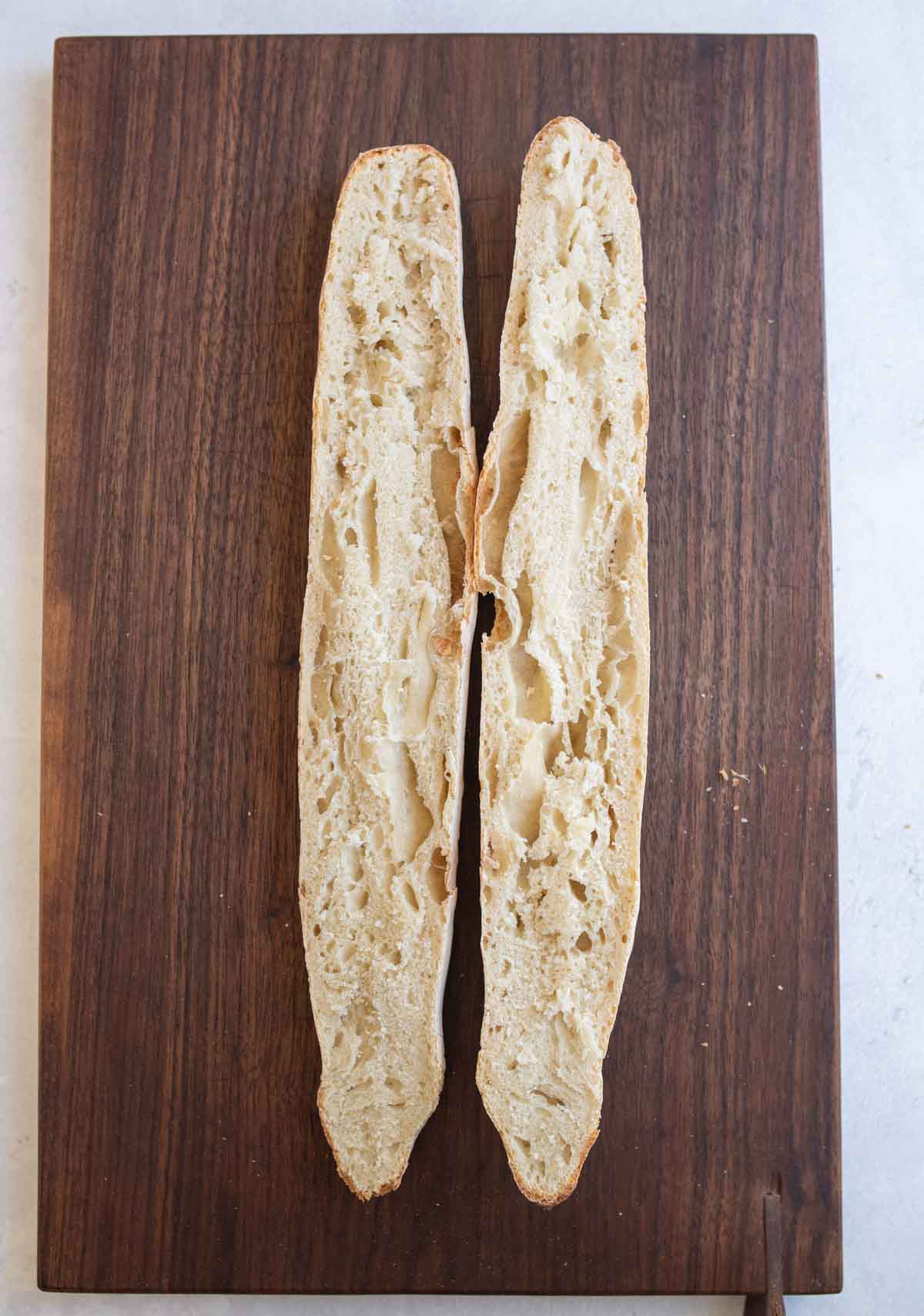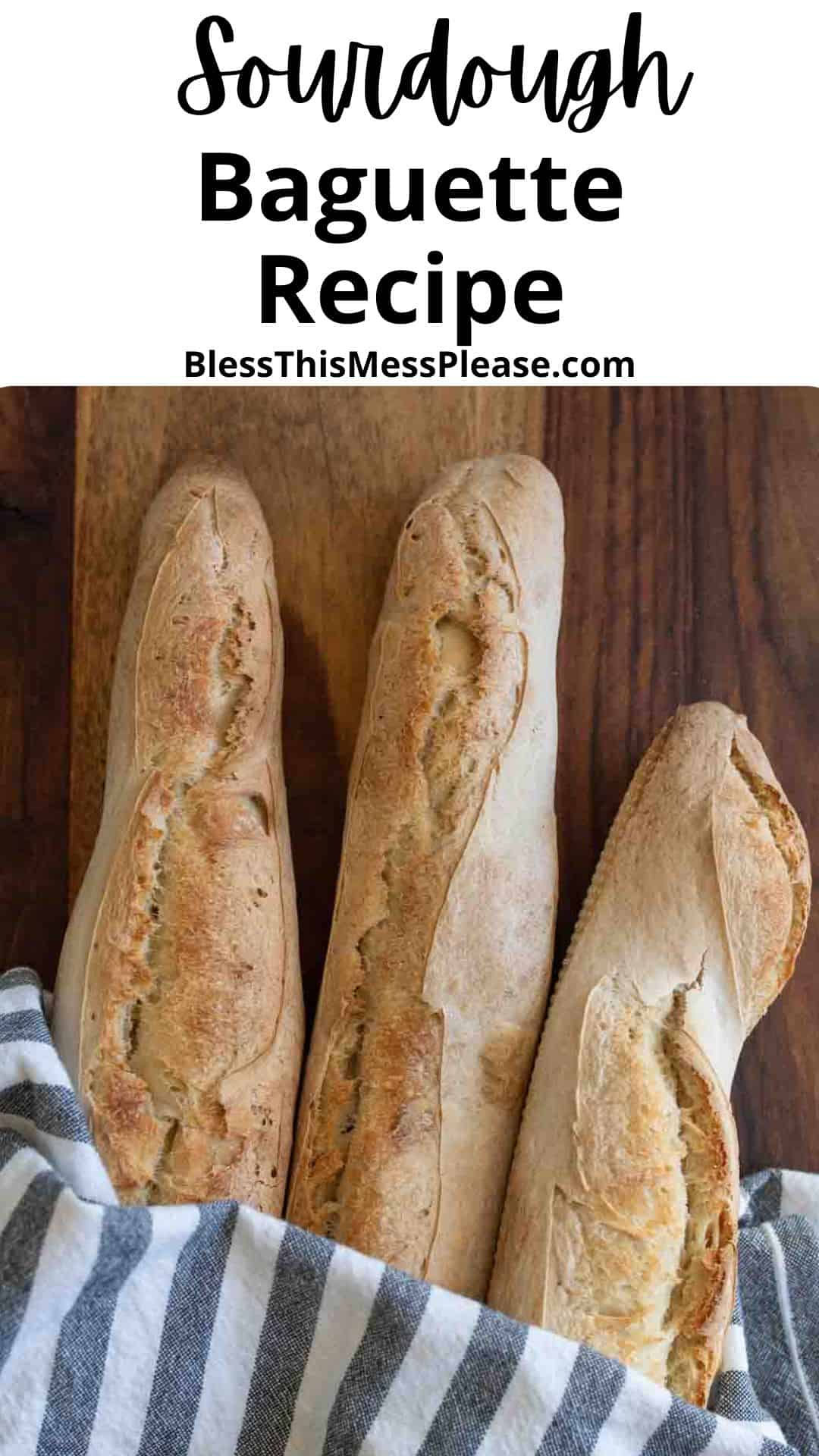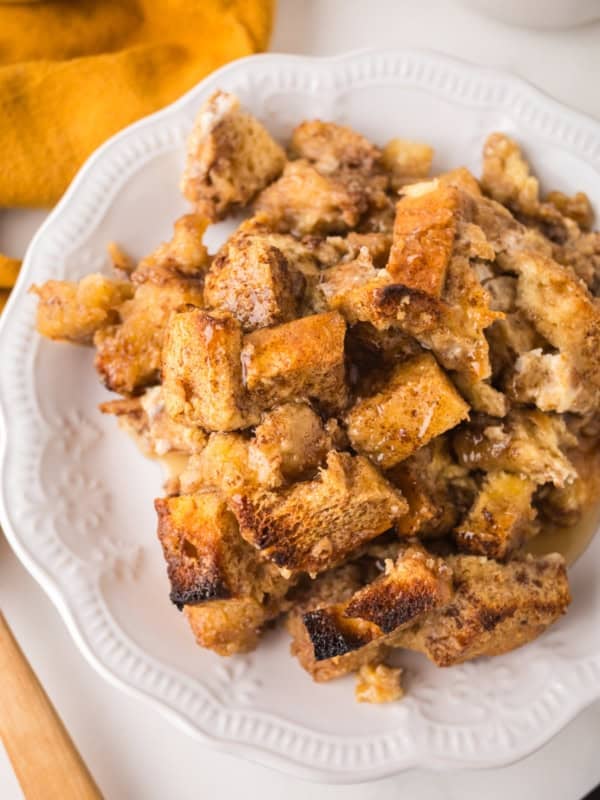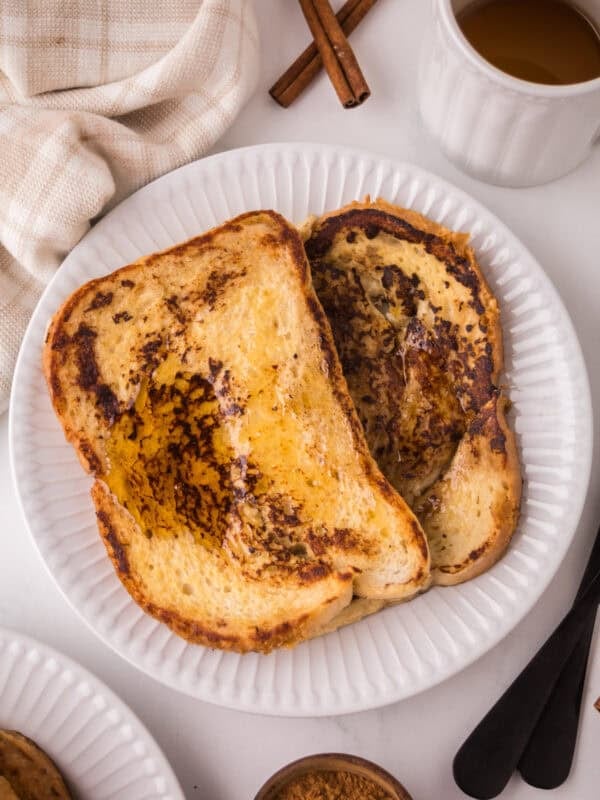This post may contain affiliate links. Please read our disclosure policy.
This recipe for sourdough baguettes takes the traditional French baguette and incorporates the natural fermentation of sourdough starter. There’s something magical about the simple elegance of a baguette—crispy on the outside with a soft, airy interior.

Whether you’re serving them fresh for lunch or dinner, these baguettes are sure to impress. And while the recipe requires time and patience, the hands-on work is minimal, making it a great project for any home baker.
I’m a huge fan of making delicious and easy sourdough breads at home, and I’m happy to add this baguette recipe to the list. Slices of sourdough baguettes are the perfect holder of summer tomato bruschetta and is a gold star addition to an everyday cheese board for appetizers or even after school snacks!
🍞🥖 New to sourdough? Find out how to make your own sourdough starter here, find my most popular and basic bread recipe here, and search the sourdough archive here.
Table of Contents

Why You’ll Love This Recipe
- Complex Flavor: The sourdough starter adds a subtle tang that complements the sweetness of honey and the classic French baguette texture.
- Crispy and Airy: These baguettes have a wonderfully crispy crust with a soft, airy interior, perfect for sandwiches or dipping in olive oil.
- Flexible Schedule: The dough can rest in the fridge for up to 18 hours, giving you flexibility to fit the baking process into your day.
- Simple Ingredients: Just a few pantry staples—flour, water, yeast, honey, and salt—combine to create a bakery-quality baguette at home.
Recipe Ingredients
- Water
- Sourdough starter
- Honey
- All-purpose flour
- Salt – I like to use fine sea salt.
See the recipe card below for full information on ingredients and quantities.

How to Make Sourdough Baguettes


Step 1: In a medium mixing bowl, combine the cool water and honey. Stir to mix well.
Step 2: Add the sourdough starter, flour, and salt, and mix until the dough starts to come together.


Step 3: Do the first set of “stretch and folds,” repeating every 30-45 minutes for a total of four rounds over the next 2-3 hours. Cover the dough between sessions.
Step 4: Cover the dough well and place it in the fridge for 12-24 hours.


Step 5: Remove the dough from the fridge and divide it into three equal pieces. Gently press each piece of dough into a rectangular shape, about 1 inch thick.
Step 6: Roll each piece into a long, thin loaf, about 12-14 inches long. Place the baguettes on a parchment-lined baking sheet or a baguette pan.


Step 5: Cover the shaped baguettes with a clean towel and let them rise for another 1-2 hours until slightly puffed.
Step 6: Score the tops of the baguettes with three to four diagonal slashes, and bake at 475°F for 20-25 minutes.
Recipe FAQs
Yes, this recipe uses a sourdough starter to provide extra flavor and fermentation. If you don’t have one, you can start a sourdough culture or use some sourdough discard from previous bakes.
Store any leftover baguettes in an airtight container or a bread bag at room temperature for up to two days. For longer storage, wrap them in plastic wrap and freeze. Reheat in the oven to refresh the crust before serving.
This allows the steam to escape and helps create that classic baguette look. Use a sharp knife or a razor blade to score the tops of the baguettes with three to four diagonal slashes.

Expert Tips
- Stretch and Fold: This technique strengthens the dough without the need for traditional kneading. Be gentle when stretching the dough to avoid tearing it. The dough will become stronger and more elastic with each session.
- Timing the Rise: The extended cold fermentation in the fridge helps develop flavor. You can adjust the time based on your schedule, but aim for at least 12 hours for the best results.
- Shaping the Baguettes: When shaping the dough, be gentle to maintain the air pockets in the dough, which will give the baguettes their characteristic airy texture.
- Baking Schedule: Plan ahead so you have a three-hour window before baking to allow the dough to rest, rise, and be shaped before baking.
Other Sourdough Breads To Try
These are some of my other dare-I-say amazing sourdough recipes that have become family favorites!
- No Knead Sourdough Bread {Easy Beginner’s Recipe}
- Soft Sourdough Sandwich Bread
- Fluffy Sourdough Rolls
- Sourdough Hamburger Buns

More Sourdough Recipes to Consider
French Toast Recipes
Sourdough French Toast Casserole
French Toast Recipes
Sourdough French Toast in 15 Minutes
Sourdough Recipes
How to Rehydrate Sourdough Starter
Sourdough Recipes
How to Dehydrate Sourdough Starter
Did you make this recipe? Leave a ⭐️ review and share it on Instagram, Facebook, or Pinterest!

Sourdough Baguettes
Ingredients
- 1 1/4 cups cool water, (300 grams)
- 1/2 cup sourdough starter, (100 grams)
- 1 tablespoon honey, (25 grams)
- 3 1/4 cups all-purpose flour, (440 grams)
- 2 teaspoons fine sea salt, (10 grams)
Instructions
- Prepare the dough: In a medium mixing bowl, combine the cool water and honey. Stir to mix well. Add the sourdough starter, flour, and salt, and mix with a wooden spoon until the dough starts to come together. The dough will be thick—just mix as well as you can to incorporate the flour. There’s no need for thorough kneading at this stage.
- Rest the dough: Cover the bowl with a lid, beeswax wrap, or plastic wrap and let the dough rest for 30 minutes. This process allows the water to hydrate the flour, making it easier to work with.
- Stretch and fold: After the dough rests, perform the first set of “stretch and folds.” To do this, reach between the dough and the side of the bowl, gently stretching the dough upward and folding it over itself. Give the bowl a quarter turn and repeat. Do this about four times, working your way around the dough. Repeat this process every 30-45 minutes for a total of four rounds over the next 2-3 hours. Cover the dough between sessions.
- Cold fermentation: After the final stretch and fold, cover the dough well and place it in the fridge for 12-24 hours. This cold fermentation helps develop flavor and allows the dough to rise slowly.
- Shape the baguettes: Remove the dough from the fridge and divide it into three equal pieces. Gently press each piece of dough into a rectangular shape, about 1 inch thick. If the dough is sticky, lightly flour the surface. Cover the pieces with a clean dish towel and let them rise for about 1 hour.
- Shape into baguettes: After the dough has rested and risen slightly, gently shape each piece into a baguette by folding the dough over itself lengthwise. Roll each piece into a long, thin loaf, about 12-14 inches long. Place the baguettes on a parchment-lined baking sheet or a baguette pan.
- Final rise: Cover the shaped baguettes with a clean towel and let them rise for another 1-2 hours until slightly puffed.
- Preheat the oven: Preheat your oven to 475°F (245°C).
- Score and bake: Just before baking, use a sharp knife or a razor blade to score the tops of the baguettes with three to four diagonal slashes. This allows the steam to escape and helps create that classic baguette look. Bake for 20-25 minutes, or until the baguettes are golden brown with a crisp crust.
- Cool and enjoy: Let the baguettes cool completely on a wire rack before slicing. Serve fresh with butter, olive oil, or use them for sandwiches.
Notes
- The dough benefits from a longer cold fermentation (12-24 hours), which enhances the flavor and structure of the baguettes. You can leave the dough in the fridge for longer if needed.
- The cold dough is always easier to work with in the beginning because it is a wetter dough than some.
- Be gentle when shaping the baguettes to avoid deflating the dough. The goal is to maintain the air bubbles inside the dough to create that perfect airy crumb.
- Scoring the dough right before baking helps control how the bread expands in the oven, giving you that beautiful baguette appearance.















I use you 3 baguette recipe whenever possible as I love the dough. Today I made 2 steak and cheese hoagies using the recipe and it turned out beautifully.
I gave used this recipe a handful of times, each time it came out beautiful and delicious. I am newish to sourdough, but this recipe is reliable. I don’t have the baguette pan but even free form shaping is beautiful. I love how you break each step so simply and your photos are perfect.
Aren’t the kind of rustic free formed loaves SO fun?! Thanks for making them Dianna, so glad you are here!